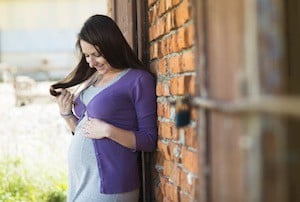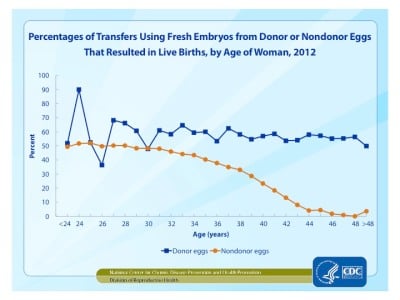Chances of Having a Baby With Donor Egg After 2 Miscarriages at 40 Years Old
« Back to Articles
Getting Pregnant at 44: What are the Chances and Options?

I am 44 years erstwhile salubrious non-smoker yoga practitioner, AMH i.45 and FSH 9, high prolactin (25) but all else normal/practiced. Cycle regular with variation b/t 28-31 days ... married recently and trying for 6 months. My husband's sperm is very good, he is 45. What are our chances for conceiving naturally? About to see rep. endocrinologist and view options, of which I think Clomid is one. The adult female who submitted this comment has a healthy lifestyle and is probably in excellent wellness but having trouble getting pregnant. The big issue is her age. She is doing the appropriate thing past consulting with a reproductive endocrinologist, but really, what are her chances and options? I recently wrote a blog on optimal infertility treatment for women around 40 years old. In that weblog, I reviewed data from a study that included women from ages 38 – 42 years. The determination was that it is okay to first with three IUI cycles merely the option with the highest pregnancy charge per unit was in vitro fertilization (IVF). In fact the majority of pregnancies in the study were with the IVF option. Simply what happens when patients go beyond this historic period range? What are the chances and options for getting pregnant at 43 and above? Yep, she could conceive naturally. The chances, still, are low. In that location is a 33 - l% chance of miscarriage and an increase in the incidence of chromosomal problems with the infant, such as Down syndrome. It is more often than not accepted that after age 40, clomiphene citrate is not very effective. The pregnancy rate is less than 5% per cycle at age 43 years. Merely, this number is not that different with other (more aggressive) options. Then, she could try a few clomiphene citrate cycles with timed intrauterine inseminations. This would be okay past me as long every bit she understands that the pregnancy charge per unit volition non be much different than them trying naturally. According to the Society for Assisted Reproductive Technologies (SART) database, in 2013 in that location were 5,744 IVF cycles nationally in women > 42 years of age. Of these, eight.ix% resulted in a pregnancy and only 4.5% resulted in a live nascency. It can be seen that almost 50% of the pregnancies resulted in a miscarriage. Only seven.3% of embryo transfers in this age group resulted in a live birth. In comparing, the alive birth rate in women ages 38 – twoscore years, 28.five% of embryo transfers resulted in a live birth. Thus, the pregnancy rate even with IVF (using her own eggs) is less than 5% in women above historic period 42 years. They are fifty-fifty lower at age 44 and practically zero at historic period 45 years. The reason the pregnancy rate is so low is that near if not all of the embryos in these women are chromosomally aberrant (aneuploid). About chromosomally abnormal embryos will not implant. If they practice implant, a lot of them volition miscarry (hence the loftier miscarriage rate). Or, if the pregnancy continues, there is an increased risk for having a baby with a chromosomal aberration. One of the strategies that is being investigated is to "pool" embryos from ii – 3 egg retrievals. Embryos are biopsied 5 days after egg retrieval (blastocyst stage) and then frozen (cryo-preserved). Nosotros then perform pre-implantation genetic screening (PGS) on the embryos. The expectation is that hopefully ane to two embryos will be "normal" (euploid) and result in a pregnancy. I have however to see a newspaper showing a good pregnancy rate using this strategy. Information technology is also very expensive to do 2 – 3 IVF cycles simply there are some patients who would exist willing to invest in this – if it works! If all the embryos turn out to be aneuploid, it may help the couple reconsider using donor eggs. A lot of my patients in this age grouping will utilise donor eggs to become pregnant. The live nascence charge per unit with this choice is around sixty% per embryo transfer. The graph beneath shows the pregnancy rates with non-donor eggs and donor eggs in women based on their age. As you can see, even after age 43, the pregnancy rate using donor eggs remains excellent. The incidence of miscarriage volition be effectually fifteen%. Likewise, the chances of having a infant with a chromosomal abnormality (due east.g. Downward syndrome) will be depression. Another handling selection that may need to exist considered is to use donor embryos. Adoption and child-free living are other options that can be considered. To see a fertility specialist that offers a wide variety of treatment options including ovulation consecration, intrauterine inseminations, IVF, PGS, egg donation and embryo donation, make an appointment at 1 of InVia's four Chicago area fertility clinics.  A reader recently posted this question on a previous web log:
A reader recently posted this question on a previous web log:Is natural conception possible?
What most clomiphene citrate?
What about IVF?
Why are IVF success rates so low in this group?
What can be done about chromosomal abnormalities?
What most donor eggs?

Are there any other options?

Source: https://www.inviafertility.com/blog/infertility/drvkarande/getting-pregnant-at-43-fertility-chances-options/